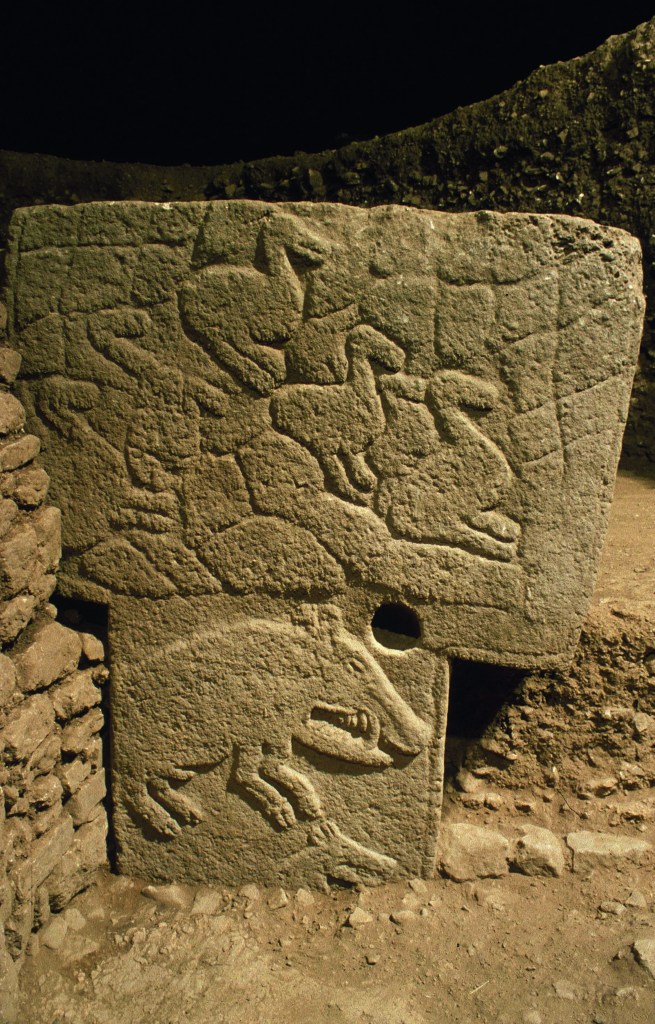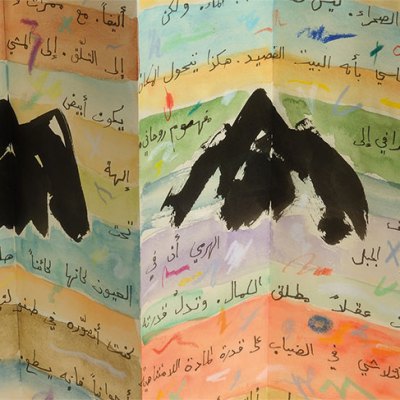One morning in May I stood in a dark room in southern Turkey, watching blue-skinned early humans domesticate wheat between bouts of interpretive dance. They were holograms, and they swayed across the walls to a doomy arrangement of bells, drums, and spectral voices: the soundtrack to the dawn of time. The display was a concession to drama in an otherwise austere complex of new museums – low, tan, elliptical structures tucked into a dip in the Harran plain – built to ease visits to Göbekli Tepe, a hilltop cluster of stone circles that is sometimes described as the earliest temple on earth. The museums take their shape from the limestone ruins a short walk up the rise, but for all the touch screens and soft-power gloss – this is the project of a large Turkish conglomerate – their raison d’être could hardly be more mysterious.
The tepe (‘hill’ in Turkish) that gives the place its name is an artificial mound, built up by degrees between 9500 and 8200 BC, by which time the structures on its flank had been filled in and abandoned. They remained buried in the hill until 1994, when a German archaeologist named Klaus Schmidt went combing through south-eastern Anatolia in search of Neolithic sites. He had helped excavate the nearby settlement of Nevalı Çori, which revealed a circular building ringed by T-shaped pillars engraved with fantastic imagery, and two larger pillars in its centre. Most remarkable was the building’s age: predating agriculture, it was the first evidence that hunter-gatherers built monumental structures, apparently as settings for ritual practices.
Cresting Göbekli Tepe, Schmidt noticed the earth was speckled with carefully dressed limestone slabs, and made an extraordinary intuitive leap: perhaps these slabs were the tops of further T-shaped columns hidden in the mound, the rims of further temples. If so, their number suggested the find was more significant than anything unearthed at Nevalı Çori. That hunter-gatherers might have erected buildings on this scale would profoundly alter our image of the creativity and complexity of early human societies. ‘I knew immediately,’ wrote Schmidt, ‘that this site would occupy the rest of my scientific life.’ (An earlier survey, in 1963, had identified Göbekli as a Neolithic site, thanks to the profusion of flint, but thought the slabs were Islamic tombstones.)
Excavations began within a few months; Schmidt led them for 20 years until his sudden death in 2014. From the belly of the hill a world was brought to light: one oval enclosure after another, cut into the bedrock and skirted with pillars, each carved with an amazing variety of animals. Wild boar bare their teeth. Five ducks arcing across one surface suggest a single bird in motion. A census drawn up by Schmidt identified hundreds of foxes, snakes and gazelles, dozens of red deer and gerbils, five hedgehogs, five wolves, and a lone priapic leopard.
Pillar 12 in Enclosure C at Göbekli Tepe in southern Turkey, with a carving of ducks in a landscape (above) and a wild boar and fox (below). Photo: D. Johannes/Deutsches Archaeologisches Institut, Berlin

Inside each space are two free-standing pillars, up to five metres high. They seem to be stylised humans: long, gently bent arms culminate in hands crossed above a girdle. Remains of a fox tail were found nearby, suggesting that the statues may have worn pelts. But what beings are these? Phalluses abound, but the only apparent representation of a female body found on the site is a piece of graffiti, now in the Urfa Museum: a squatting figure in labour. Schmidt thought that the lack of female depictions, linked to fertility and life, and common in other Neolithic settlements of the Near East, supported the view of Göbekli as a place for the cult of the dead.
High benches along the inner walls, too high for a human to reach without a ladder, seem designed for ritual rather than rest. Basins at the foot of pillars may have held offerings, or possibly beer. Stones jutting from walls may have carried lamps. That the carvings were made before the domestication of wild animals makes them all the harder to read. What did these creatures mean to the people who quarried, raised and chiselled 10-ton pillars to represent them? Wildness is a post-agricultural concept, marking out that which has not been brought under human control. Göbekli Tepe appears to record a world on its way out: if animals were not a new motif (the cave paintings of Chauvet or Altamira are many thousands of years older), these images break with Palaeolithic art by raising one species above the rest.
Why humans gave up hunting and gathering to farm and herd is one of the animating questions of archaeology. The hills around Göbekli Tepe are thought to be the place of origin of cultivated grain. Schmidt’s theory, and the reason why his finds are so remarkable, is that building these temples, the labour of several hundred people over months and years, led to the development of new ways of providing food. His discovery bore out Jacques Cauvin’s notion of a ‘symbolic revolution’: that it was changes in belief that led to shifts in economic systems; that worship gave rise to agriculture, not the other way around.
Nations often worry about their distance from a moment of origin; the history of the Turkish republic is full of attempts to prove the antiquity and brilliance of national culture (often with defensive reference to the ‘Greek miracle’). The striking thing is that the new museums at Göbekli and their bold claims – the appropriation of Neolithic architecture by modern Turks – have arrived at a time of deep scholarly uncertainty about the site’s meaning. ‘We are in a reinterpretational phase,’ said one of the team of archaeologists who have taken over the dig. Nine enclosures have been or are being excavated; geophysical analysis has shown there are more than 10 more buried in the mound. But to excavate a place is to make it vulnerable. It is also to destroy archaeological contexts, which is why only part of any area has been uncovered, to give future scientists the chance to approach the material with new questions and methods.
The team’s energies have shifted from digging to protecting what has been found. A roof has been built over the site and a walkway around it, allowing visitors to peer in to the poppy-ringed hollow. The museums, invisible from the mound itself, are unusually sensitive interventions in an exposed environment. As you climb the gentle slope to the site, the eye is drawn off the path to the odd bright yellow tuft. Mustard loves this gravel, one of the architects told me as it crunched underfoot. He hopes that by next year the path will have grown a golden border.
From the July/August issue of Apollo. Preview and subscribe here.


